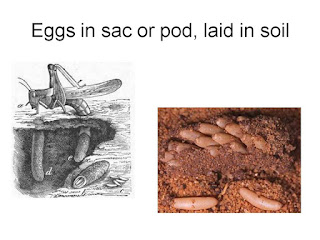Insect Orders- Apterygota, Exopterygota
https://www.youtube.com/watch?v=Ezq_JWd1Sd8
APTERYGOTA
Order COLLEMBOLA
Springtails,
Snowfleas, Collembolans
Coll – glue
Embola – wedge or bolt
• Pre-genital appendages
• I segment - Ventral tube or collophore or glue peg
• III segment – Hamula or Retinaculum or spring
holder
• IV segment – Furcula or springing organ.
Order THYSANURA
Silverfish, Bristletails, Slickers,
Firebrats
Thysan – bristle or
fringe
Ura – tail
• Long filiform antenna
• Lateral styliform pre-genital appendages
• Long cerci & elongate median caudal filament
• Long life span; more than 3 to 4 years.
PTERYGOTA
EXOPTERYGOTA
Order ODONATA
Dragonflies
and Damselflies
Odon – tooth
• Predaceous
• Mouthparts – strong mandible, maxilla with a tooth
like structure called “mala”, labium of
naiads modified as “mask”
• Large compound eyes
• Membranous wings with stigma
• Legs – forwardly directed, like a basket to hold &
transfer prey to mouth
Suborder
Anisoptera Suborder
Zygoptera
Dragonflies Damselflies
Stout, large, fast fliers Slender, narrow, slow fliers
Holoptic eyes Dichoptic eyes
Unequal wings Equal wings
Wings laterally spread at rest Wings held dorsally over the abdomen at rest
Naiads with rectal gills known Naiads with leaf like caudal gills
as branchial basket
Order EPHEMEROPTERA
Mayflies,
Dayflies, Ephemerids
Ephemeron – living for a
day
Ptera – wings
•
Delicate,
slender adults, living for 1 or 2 days
•
Triangular
wings, fore wings larger than hind wings
• Long cerci with or without median caudal filament
• Hemimetabola, winged instar before adult stage
called sub-imago
• Nymphs moult as many as 23 times, long development
period, 1 to 3 years.
Order PHASMIDA
Stick insect, leaf
insect, walking sticks, phasmids
Phasm – an apparition (a
supernatural appearance)
• Stick or leaf like
• Phytophagous
• Prothorax short, meso- and metathorax long
• Long filiform antenna (thread like, segments
uniform, elongate)
• Wing venation in leaf insects mimics leaves
• Eggs – ootheca
• Camouflage, thanatosis (feigning dead), reflex
autotomy between femur and trochanter
1.
Family
Phasmatidae (Stick insects)
2.
Family
Phyllidae (Leaf insects)
Order ORTHOPTERA
Grasshoppers, locusts,
crickets, katydids, mole crickets
Ortho – Straight
ptera – wings
•
Mandibulate
mouth parts
•
Tegmina fore
wings, brachyterous or apterous forms noticed
•
Hind legs –
jumping type (saltatorial)
Suborder
Ensifera
Long horned grasshoppers, mole
crickets, crickets, katydids
Suborder
Caelifera
Short horned grasshoppers, locusts
Family Tettigoniidae
Long horned
grasshoppers, katydids
Ø Long antennae
Ø Sword like ovipositor
Ø Winged as well as wingless forms present.
Family Gryllidae
Crickets
Ø Nocturnal Songsters
Ø Long antenna
Ø Hind wings elongated into a pair of long
processes
Ø Auditory organs in fore tibia
Ø Sound producing organs in wings.
Family Gryllotalpidae
Mole crickets
Ø Subterranean,
burrowing into moist soil
Ø Short antennae
Ø Fore legs digging type (fossorial)
Ø Damage roots of plants.
Family Acrididae
Short
horned grasshoppers and locusts
Ø Short antennae
Ø Short ovipositor
Ø Auditory organs at first abdominal segment.
Ø Eggs in sac or pod, laid in soil
Ø Locusts are the most serious crop pests in
many African and Asian countries. They are polymorphic having solitary and gregarious
forms. In the gregarious form, they swarm in large numbers in search of food.
Such locust swarms lead to severe crop loss and in turn famine.





































Comments
Post a Comment